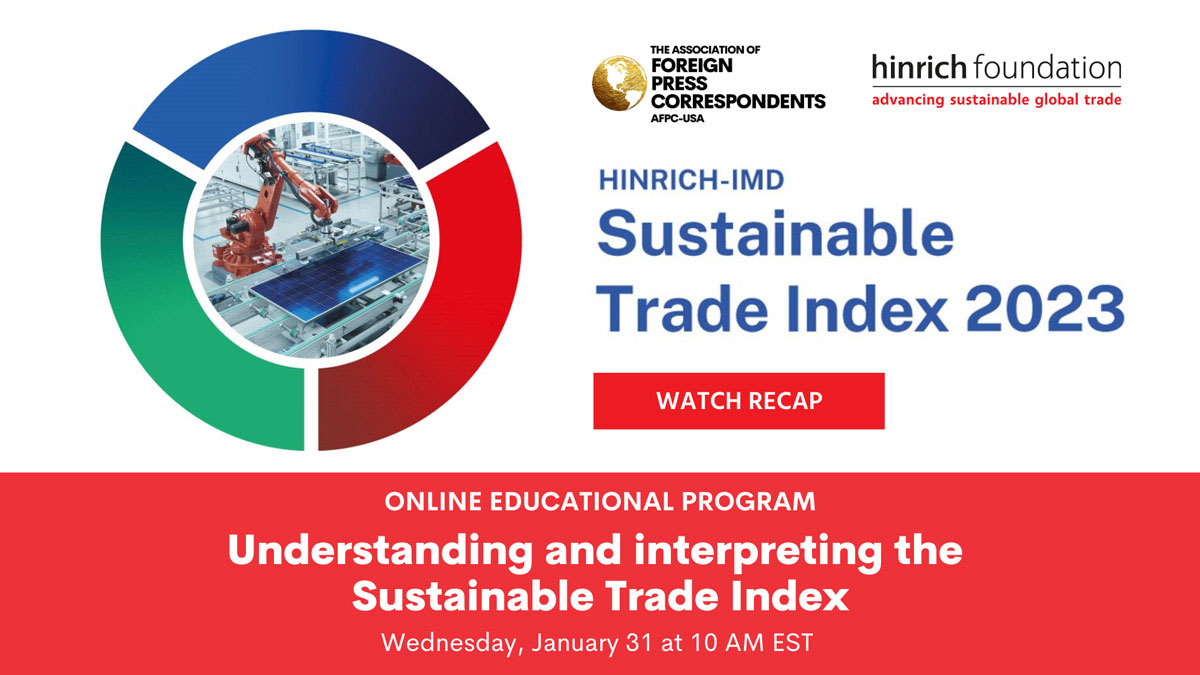Understanding and interpreting the Sustainable Trade Index
Published 26 March 2024
The world is witnessing a shift from an era of rapid globalization to one of trade fragmentation and rising protectionism. The Hinrich-IMD Sustainable Trade Index 2023 assesses how this new reality is transforming global trade, economic policies, and sustainability practices. IMD Chief Economist Christos Cabolis discusses the index’s key findings.
For a better understanding of this index, the Association of Foreign Press Correspondents (AFPC-USA) interviewed Christos Cabolis, the Chief Economist and Head of Operations at the IMD World Competitiveness Center, and an Adjunct Professor of Economics and Competitiveness.
This educational program, developed in partnership with the Hinrich Foundation, was held on January 31 and moderated by Patrícia Vasconcellos, the White House Correspondent for the Brazilian television network SBT and a Board Member of the Club of Foreign Correspondents in the United States (AFPC-USA Club).
Before joining IMD, Cabolis was an Associate Professor of Economics and Finance at ALBA Graduate Business School at The American College of Greece. He was the Executive Director of the International Center for Finance at Yale School of Management from 2002-2004. From 1997- 2002 he was a lecturer of Economics at Yale University where he also served as the Dean of Jonathan Edwards College. Cabolis has also taught at the University of California at Santa Barbara and the University of North Carolina's Kenan-Flagler Business School.
Cabolis holds a BA from the University of Athens, an MA from the California State University, Long Beach, and a Ph.D. in Economics from the University of California at Santa Barbara. He has published in the Review of Financial Studies, Journal of Law and Economics, and Journal of Banking and Finance among others. Christos is also the recipient of the Inaugural "Jaime Fernandez de Araoz" Award in Corporate Finance.
The AFPC-USA is solely responsible for the content of this educational program. The main takeaways are included below.
What is the 2023 Sustainable Trade Index?
-
The index measures the capacity of 30 major global economies to participate in the trade system in a manner that supports long-term growth, social capital development, and environmental protection.
-
The index is based on 71 indicators that are divided in three pillars: economic, societal and environmental.
Main findings
-
New Zealand tops the rankings for a second year running.
-
The UK continues to perform strongly at the pillar level and places second in this year’s ranking.
-
Singapore ranks third due its strong performance in the economic pillar.
-
Hong Kong ranks fourth overall and third in the economic pillar.
-
Australia rounds out the top five ranking economies.
Understanding each pillar
-
Under the economic pillar, those with a robust infrastructure and strong inclination towards technological innovation stand out. The economies that perform the highest in the economic pillar are Singapore, South Korea, Hong Kong and the United States.
-
In the societal pillar, economies that improved their standing are characterized by political stability, economic equity, high educational attainment, and social mobility. Canada, New Zealand and Australia occupy the first, second and third place in this pillar. India, Papua New Guinea and Myanmar are in the last positions.
-
In the environmental pillar the top ranks are occupied by economies that uphold high environmental standards and effectively tackle challenges related to wastewater, air pollution, carbon emissions, and energy intensity. The highest positions in the environmental pillar are taken by New Zealand, United Kingdom and Mexico. The countries at the last positions and therefore economies with substantial room for improvement are India, Brunei and Russia.
Why is the index so important to society?
-
The index provides policymakers, businesses and civil society reliable information to make informed decisions. It offers a comprehensive assessment of trade readiness by highlighting the strengths for each economy as well as areas for improvement. We are increasingly recognizing that a complex challenge, such as climate damage, needs a holistic approach that reflects an understanding of the 17 Sustainable Development Goals (SDGs).
-
Trade has been a prevailing engine for economic growth, but it must be sustainable. Cabolis argues that a significant challenge lies in the lack of sufficient data and clear metrics for defining and measuring objectives. The Hinrich Foundation’s effort to address this issue began several years ago. The IMD World Competitiveness Center joined this initiative four years ago with a focus on enhancing the foundation’s great work.
-
He says that the STI emphasizes that the economic, societal and environmental pillars do not align seamlessly. Their interplay is nonlinear, highlighting their underlying complexity.
Perspective for foreign journalists
-
Cabolis underlines that the index results shouldn’t be uniformly interpreted across all countries represented. He asserts that foreign correspondents intending to report on those figures must have a comprehensive understanding of each region worldwide.
-
"Something evident in the Sustainable Trade Index as well as in many other rankings we produce is that there is no 'one size fits all.' Each country presents unique challenges and opportunities. For example, discussions about New Zealand would differ significantly from those relating to the United Kingdom, and entirely different issues would arise when considering countries like China or India," says Cabolis.
-
When assessing how countries utilize natural resources, it is crucial to examine the impact on trade and environment particularly whether the nation depends on renewable or non-renewable resources.
© The Hinrich Foundation. See our website Terms and conditions for our copyright and reprint policy. All statements of fact and the views, conclusions and recommendations expressed in this publication are the sole responsibility of the author(s).

